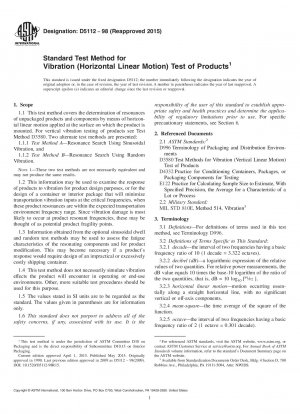ASTM D5112-98(2015)
Standard Test Method for Vibration (Horizontal Linear Motion) Test of Products
- Standard No.
- ASTM D5112-98(2015)
- Release Date
- 1998
- Published By
- American Society for Testing and Materials (ASTM)
- Status
- Replace By
- ASTM D5112-22
- Latest
- ASTM D5112-22
- Scope
4.1 Products are exposed to complex dynamic stresses in the transportation environment. The determination of the resonant frequencies of the product, either horizontal, vertical or both, aids the package designer in determining the proper packaging system to provide adequate protection of the product, as well as providing an understanding of the complex interactions between the components of the product as they relate to expected transportation vibration inputs.
1.1 This test method covers the determination of resonances of unpackaged products and components by means of horizontal linear motion applied at the surface on which the product is mounted. For vertical vibration testing of products see Test Method D3580. Two alternate test methods are presented:
1.1.1 Test Method A—Resonance Search Using Sinusoidal Vibration, and
1.1.2 Test Method B—Resonance Search Using Random Vibration.
Note 1: These two test methods are not necessarily equivalent and may not produce the same results.
1.2 This information may be used to examine the response of products to vibration for product design purposes, or for the design of a container or interior package that will minimize transportation vibration inputs at the critical frequencies, when these product resonances are within the expected transportation environment frequency range. Since vibration damage is most likely to occur at product resonant frequencies, these may be thought of as potential product fragility points.
1.3 Information obtained from the optional sinusoidal dwell and random test methods may be used to assess the fatigue characteristics of the resonating components and for product modification. This may become necessary if a product's response would require design of an impractical or excessively costly shipping container.
1.4 This test method does not necessarily simulate vibration effects the product will encounter in operating or end-use environments. Other, more suitable test procedures should be used for this purpose.
1.5 The values stated in SI units are to be regarded as the standard. The values given in parentheses are for information only.
1.6 This standard does not purport to address all of the safety concerns, if any, associated with its use. It is the responsibility of the user of this standard to establish appropriate safety and health practices and determine the applicability of regulatory limitations prior to use. For specific precautionary statements, see Section 6.
ASTM D5112-98(2015) Referenced Document
- ASTM D3580 Standard Test Methods for Vibration (Vertical Linear Motion) Test of Products*, 2015-04-01 Update
- ASTM D4332 Standard Practice for Conditioning Containers, Packages, or Packaging Components for Testing*, 1999-04-20 Update
- ASTM D996 Standard Terminology of Packaging and Distribution Environments*, 1999-04-20 Update
- ASTM E122 Standard Practice for Calculating Sample Size to Estimate, With a Specified Tolerable Error, the Average for Characteristic of a Lot or Process*, 2000-10-10 Update
ASTM D5112-98(2015) history
- 2022 ASTM D5112-22 Standard Test Method for Vibration (Horizontal Linear Motion) Test of Products
- 1998 ASTM D5112-98(2015) Standard Test Method for Vibration (Horizontal Linear Motion) Test of Products
- 1998 ASTM D5112-98(2009) Standard Test Method for Vibration (Horizontal Linear Sinusoidal Motion) Test of Products
- 1998 ASTM D5112-98(2003) Standard Test Method for Vibration (Horizontal Linear Sinusoidal Motion) Test of Products
- 1998 ASTM D5112-98 Standard Test Method for Vibration (Horizontal Linear Sinusoidal Motion) Test of Products
